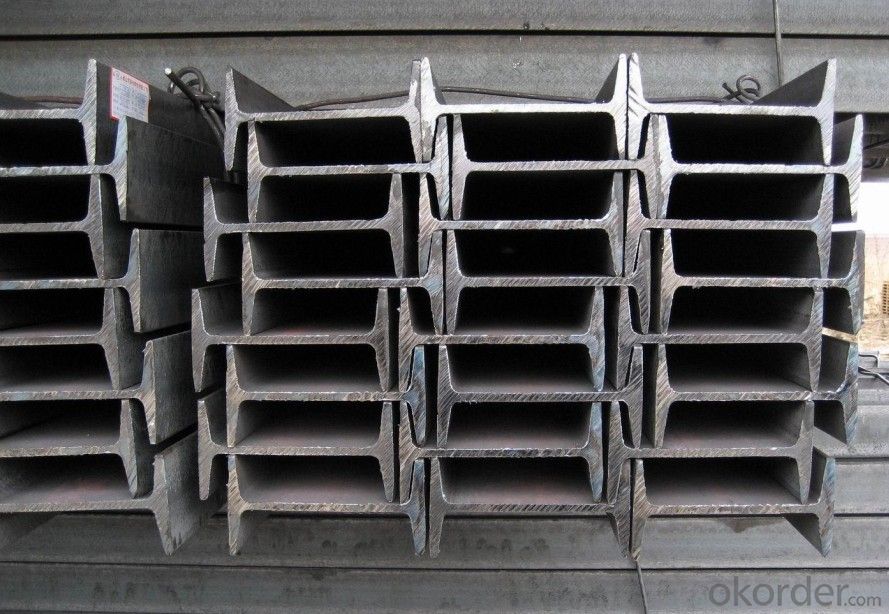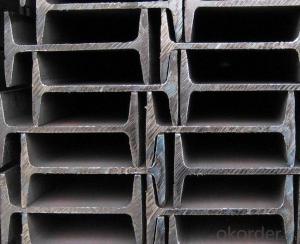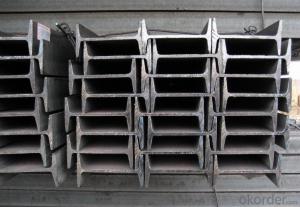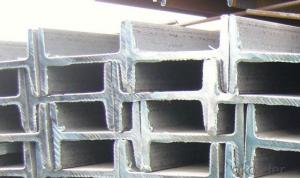IPE/IPEAA in European Standard with Grade Q235
- Loading Port:
- Tianjin
- Payment Terms:
- TT OR LC
- Min Order Qty:
- 25 m.t
- Supply Capability:
- 10000 m.t/month
OKorder Service Pledge
OKorder Financial Service
You Might Also Like
Product Description:
OKorder is offering high quality Hot Rolled Steel I-Beams at great prices with worldwide shipping. Our supplier is a world-class manufacturer of steel, with our products utilized the world over. OKorder annually supplies products to European, North American and Asian markets. We provide quotations within 24 hours of receiving an inquiry and guarantee competitive prices.
Product Applications:
1. Supporting members, most commonly in the house raising industry to strengthen timber bears under houses. Transmission line towers, etc
2. Prefabricated structure
3. Medium scale bridges
4. It is widely used in various building structures and engineering structures such as roof beams, bridges, transmission towers, hoisting machinery and transport machinery, ships, industrial furnaces, reaction tower, container frame and warehouse etc.
Product Advantages:
OKorder's Steel I-Beams are durable, strong, and resist corrosion.
Main Product Features:
· Premium quality
· Prompt delivery & seaworthy packing (30 days after receiving deposit)
· Corrosion resistance
· Can be recycled and reused
· Mill test certification
· Professional Service
· Competitive pricing
Product Specifications:
1. Invoicing on theoretical weight or actual weight as customer request
2. Standard: EN10025, GB Standard, ASTM
3. Grade: Q235B, Q345B, SS400, ASTM A36, S235JR, S275JR
4. Length: 5.8M, 6M, 9M, 12M as following table
5. Sizes: 80mm-270mm
Dimensions(mm) | |||||
h | b | s | t | Mass Kg/m | |
IPE80 | 80 | 46 | 3.80 | 5.20 | 6.00 |
IPE100 | 100 | 55 | 4.10 | 5.70 | 8.10 |
IPE120 | 120 | 64 | 4.80 | 6.30 | 10.40 |
IPE140 | 140 | 73 | 4.70 | 6.90 | 12.90 |
IPE160 | 160 | 82 | 5.00 | 7.40 | 15.80 |
IPE180 | 180 | 91 | 5.30 | 8.00 | 18.80 |
IPE200 | 200 | 100 | 5.60 | 8.50 | 22.40 |
IPE220 | 220 | 110 | 5.90 | 9.20 | 26.20 |
IPE240 | 240 | 120 | 6.20 | 9.80 | 30.70 |
IPE270 | 270 | 135 | 6.60 | 10.20 | 36.10 |
FAQ:
Q1: Why buy Materials & Equipment from OKorder.com?
A1: All products offered byOKorder.com are carefully selected from China's most reliable manufacturing enterprises. Through its ISO certifications, OKorder.com adheres to the highest standards and a commitment to supply chain safety and customer satisfaction.
Q2: How do we guarantee the quality of our products?
A2: We have established an advanced quality management system which conducts strict quality tests at every step, from raw materials to the final product. At the same time, we provide extensive follow-up service assurances as required.
Q3: The products are invoicing on theoritical weight or on actual weight?
A3: We can do it in both manners, according to the customers' request.
Images:


- Q:How do steel I-beams perform in areas with high seismic activity?
- Steel I-beams perform well in areas with high seismic activity due to their structural properties. I-beams are known for their strength, stiffness, and ability to resist lateral forces, making them suitable for seismic zones. The inherent rigidity of steel helps to distribute seismic forces throughout the structure, reducing the risk of collapse during an earthquake. Additionally, steel I-beams can be designed and reinforced to withstand specific seismic loads, ensuring the safety and stability of buildings in such areas.
- Q:Can steel I-beams be used for telecommunications infrastructure?
- No, steel I-beams are not typically used for telecommunications infrastructure. Telecommunications infrastructure typically requires lighter materials that can support the installation of equipment such as antennas and cables. Steel I-beams are more commonly used in construction for their strength and load-bearing capabilities.
- Q:How are steel I-beams transported and delivered to construction sites?
- Steel I-beams are typically transported and delivered to construction sites using specialized equipment and vehicles. The transportation process involves several steps to ensure the safe and efficient delivery of these heavy and large structural components. Firstly, the steel I-beams are usually manufactured at steel mills or fabrication plants. Once the production is complete, they are typically loaded onto flatbed trucks or trailers. These trucks are equipped with cranes or other lifting mechanisms to facilitate the loading and unloading of the I-beams. During transportation, the steel I-beams are secured onto the flatbed trucks using chains, straps, or other fastening devices to prevent any movement or damage during transit. Special care is taken to ensure that the beams are balanced and distributed evenly on the trailer to maintain stability and prevent any accidents. In some cases, if the I-beams are too long or heavy to be transported as a single unit, they may be divided into smaller sections for easier handling and transportation. These sections are usually joined together at the construction site using welding or bolting techniques. Once the steel I-beams arrive at the construction site, they are carefully unloaded using cranes or forklifts. The construction crew follows strict safety protocols to ensure the beams are safely placed in the designated area. The delivery process may involve coordinating with the construction project manager or site supervisor to ensure that the I-beams are delivered at the right time and in the correct sequence for the construction process. Overall, the transportation and delivery of steel I-beams to construction sites require careful planning, coordination, and the use of specialized equipment. This ensures that these essential structural components are safely transported and ready for installation, contributing to the progress of construction projects.
- Q:Can steel I-beams be used in coastal areas with high levels of salt exposure?
- While coastal areas with high levels of salt exposure can indeed utilize steel I-beams, it is imperative to implement specific measures to ensure their durability and longevity. The corrosion process of steel can be accelerated by salt exposure, resulting in rust and deterioration. Nevertheless, the implementation of corrosion-resistant coatings or materials like galvanized steel or stainless steel will enable the I-beams to endure the harsh coastal environment. Furthermore, it is essential to conduct regular maintenance and inspections to promptly detect any indications of corrosion and take appropriate actions to prevent further harm. Employing proper drainage systems and protective coatings can also minimize saltwater contact and mitigate the consequences of salt exposure. Overall, with the application of suitable precautions and maintenance practices, steel I-beams can be successfully employed in coastal areas with high levels of salt exposure.
- Q:Can steel I-beams be used in architectural designs?
- Yes, steel I-beams can be commonly used in architectural designs. They are versatile, durable, and provide strong structural support, making them suitable for various applications such as bridges, high-rise buildings, and industrial structures.
- Q:How do steel I-beams contribute to the overall durability of a structure?
- There are several ways in which steel I-beams enhance the overall durability of a structure. To begin with, their unique shape, featuring a vertical web and horizontal flanges, offers a remarkable strength-to-weight ratio. As a result, they can bear heavy loads without excessive deflection or deformation, effectively distributing the weight of the structure and minimizing the risk of failure or collapse. Additionally, steel I-beams possess exceptional tensile and compressive strength, enabling them to withstand both pulling and pushing forces. This is especially crucial in areas prone to natural disasters like hurricanes or earthquakes, as these beams can absorb and distribute the energy generated by such events, preventing catastrophic failures. Moreover, steel I-beams exhibit high resistance to corrosion, which is essential for the long-term durability of a structure. These beams are often galvanized or coated with protective layers, effectively shielding them from rust and deterioration caused by moisture, chemicals, or environmental factors. Consequently, their strength and structural integrity remain intact over time. Furthermore, steel I-beams are easily fabricated and assembled, facilitating efficient construction processes. Their standardized sizes and shapes allow for accurate calculations and precise connections, reducing the likelihood of construction errors and ensuring a more durable structure. Lastly, steel I-beams boast a long lifespan, providing durability throughout the entire life of a structure. They do not deteriorate or weaken over time, making them a reliable choice for both residential and commercial buildings. Additionally, their recyclability contributes to the overall environmental durability of a structure, making them a sustainable option. In conclusion, steel I-beams significantly enhance the overall durability of a structure through their impressive strength-to-weight ratio, resistance to corrosion, ability to withstand various forces, ease of fabrication, and long lifespan. Their structural efficiency and reliability make them an indispensable component in constructing durable and resilient buildings.
- Q:Can Steel I-Beams be used for modular construction?
- Yes, Steel I-Beams can be used for modular construction. They are commonly used in modular construction due to their strength, durability, and ability to support heavy loads. Steel I-Beams provide structural stability and are often used as a framework for modular buildings.
- Q:Can steel I-beams be used in government or municipal buildings?
- Yes, steel I-beams can certainly be used in government or municipal buildings. In fact, steel I-beams are widely utilized in the construction of various types of buildings, including government and municipal structures. The high strength and durability of steel make it an excellent choice for supporting heavy loads and ensuring the structural integrity of the building. Additionally, steel I-beams offer flexibility in design, allowing for versatile and efficient construction solutions.
- Q:What are the considerations for fire rating steel I-beams?
- When considering fire rating for steel I-beams, several factors need to be taken into account. First and foremost, the material used in the construction of the I-beams must be fire-resistant or have a high fire-resistant coating. Additionally, the size and shape of the beams, as well as their positioning and spacing, should be carefully evaluated to ensure proper fire protection. It is also crucial to consider the fire rating requirements specified by local building codes and regulations. Regular inspections and maintenance of the I-beams are necessary to ensure their fire resistance remains intact over time.
- Q:What are the considerations for waterproofing when using steel I-beams?
- When it comes to waterproofing steel I-beams, there are a number of important factors that need to be considered. First and foremost, it is absolutely vital to make sure that the steel beams are properly coated or treated in order to prevent corrosion. Steel is susceptible to rust and degradation when exposed to moisture, so it is crucial to apply a high-quality protective coating or treatment to the surface of the beams. This will help to maintain their structural integrity and prevent water from seeping into the material. Another aspect that needs to be taken into account is the connection points between the steel beams and other structural elements, such as walls or floors. These connection points must be carefully sealed in order to prevent any water from infiltrating. The use of waterproof sealants or gaskets at these junctions can help create a watertight barrier and prevent any potential leaks. Additionally, it is important to ensure that the design and construction of the building incorporate proper drainage systems to redirect water away from the steel beams. This can involve the installation of gutters, downspouts, and appropriate slope in the surrounding landscape to ensure proper water runoff. By effectively managing the flow of water, the risk of water pooling or accumulating around the steel beams is minimized. Furthermore, it is essential to take into consideration the possibility of condensation forming on the steel beams. When warm air comes into contact with cold surfaces, condensation can occur, leading to the build-up of moisture. To prevent this, it is necessary to install proper insulation to maintain a consistent temperature and minimize temperature differences that could cause condensation. Adequate ventilation should also be provided to allow any trapped moisture to escape. Lastly, regular inspection and maintenance are key to ensuring the long-term waterproofing of steel I-beams. Periodic checks should be carried out to identify any signs of water damage, corrosion, or leaks. If any issues are detected, such as the need to reapply coatings, reseal connection points, or address drainage problems, prompt repairs should be undertaken. In conclusion, when waterproofing steel I-beams, it is essential to address the risk of corrosion, seal connection points, manage water drainage, prevent condensation, and conduct regular maintenance. By taking these factors into consideration, the structural integrity of the steel beams can be preserved, ensuring the long-lasting durability of the overall construction.
1. Manufacturer Overview |
|
|---|---|
| Location | |
| Year Established | |
| Annual Output Value | |
| Main Markets | |
| Company Certifications | |
2. Manufacturer Certificates |
|
|---|---|
| a) Certification Name | |
| Range | |
| Reference | |
| Validity Period | |
3. Manufacturer Capability |
|
|---|---|
| a)Trade Capacity | |
| Nearest Port | |
| Export Percentage | |
| No.of Employees in Trade Department | |
| Language Spoken: | |
| b)Factory Information | |
| Factory Size: | |
| No. of Production Lines | |
| Contract Manufacturing | |
| Product Price Range | |
Send your message to us
IPE/IPEAA in European Standard with Grade Q235
- Loading Port:
- Tianjin
- Payment Terms:
- TT OR LC
- Min Order Qty:
- 25 m.t
- Supply Capability:
- 10000 m.t/month
OKorder Service Pledge
OKorder Financial Service
Similar products
New products
Hot products
Related keywords





























